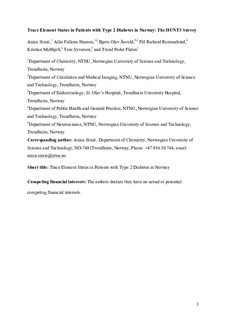Trace element status in patients with type 2 diabetes in Norway: The HUNT3 Survey
| dc.contributor.author | Simic, Anica | |
| dc.contributor.author | Hansen, Ailin Falkmo | |
| dc.contributor.author | Åsvold, Bjørn Olav | |
| dc.contributor.author | Romundstad, Pål Richard | |
| dc.contributor.author | Midthjell, Kristian | |
| dc.contributor.author | Syversen, Tore | |
| dc.contributor.author | Flaten, Trond Peder | |
| dc.date.accessioned | 2017-11-06T08:31:13Z | |
| dc.date.available | 2017-11-06T08:31:13Z | |
| dc.date.created | 2017-08-16T14:46:21Z | |
| dc.date.issued | 2017 | |
| dc.identifier.citation | Journal of Trace Elements in Medicine and Biology. 2017, 41 91-98. | nb_NO |
| dc.identifier.issn | 0946-672X | |
| dc.identifier.uri | http://hdl.handle.net/11250/2464118 | |
| dc.description.abstract | Several epidemiological studies have indicated that a number of trace elements may play a role in type 2 diabetes (T2D). We investigated the association between prevalent T2D and the concentrations of 25 trace elements in whole blood, and the relationships between T2D duration and blood levels of the trace elements that we found to be related to T2D prevalence. In this population based case-control study, 267 patients with self-reported T2D and 609 controls (frequency matched), were selected from the third Nord-Trøndelag Health Survey. Trace element blood levels were determined by high resolution inductively coupled plasma-mass spectrometry. Multivariable conditional logistic regression and multivariable linear regression were used to estimate associations. The prevalence of T2D was positively associated with boron, calcium and silver, and inversely associated with indium, lead and magnesium (Ptrend < 0.05). We found no statistical evidence for associations between blood levels of arsenic, bromine, cadmium, cesium, chromium, copper, gallium, gold, manganese, mercury, molybdenum, nickel, rubidium, selenium, strontium, tantalum, thallium, tin and zinc and T2D prevalence. After corrections for multiple testing, associations remained significant for calcium and lead (Qtrend < 0.05), and borderline significant for magnesium, silver and boron. With increasing disease duration, higher calcium levels were observed (P < 0.05). This study suggests an association between prevalent T2D and blood levels of boron, calcium, indium, lead, magnesium and silver. | nb_NO |
| dc.language.iso | eng | nb_NO |
| dc.publisher | Elsevier | nb_NO |
| dc.rights | Attribution-NonCommercial-NoDerivatives 4.0 Internasjonal | * |
| dc.rights.uri | http://creativecommons.org/licenses/by-nc-nd/4.0/deed.no | * |
| dc.title | Trace element status in patients with type 2 diabetes in Norway: The HUNT3 Survey | nb_NO |
| dc.type | Journal article | nb_NO |
| dc.type | Peer reviewed | nb_NO |
| dc.description.version | acceptedVersion | nb_NO |
| dc.source.pagenumber | 91-98 | nb_NO |
| dc.source.volume | 41 | nb_NO |
| dc.source.journal | Journal of Trace Elements in Medicine and Biology | nb_NO |
| dc.identifier.doi | 10.1016/j.jtemb.2017.03.001 | |
| dc.identifier.cristin | 1486707 | |
| dc.description.localcode | © 2017. This is the authors’ accepted and refereed manuscript to the article. LOCKED until 2.3.2018 due to copyright restrictions. This manuscript version is made available under the CC-BY-NC-ND 4.0 license http://creativecommons.org/licenses/by-nc-nd/4.0/ | nb_NO |
| cristin.unitcode | 194,66,25,0 | |
| cristin.unitcode | 194,65,25,0 | |
| cristin.unitcode | 194,65,20,15 | |
| cristin.unitcode | 194,65,20,0 | |
| cristin.unitcode | 194,65,30,0 | |
| cristin.unitname | Institutt for kjemi | |
| cristin.unitname | Institutt for sirkulasjon og bildediagnostikk | |
| cristin.unitname | Helseundersøkelsen i Nord-Trøndelag | |
| cristin.unitname | Institutt for samfunnsmedisin og sykepleie | |
| cristin.unitname | Institutt for nevromedisin og bevegelsesvitenskap | |
| cristin.ispublished | true | |
| cristin.fulltext | postprint | |
| cristin.qualitycode | 1 |

